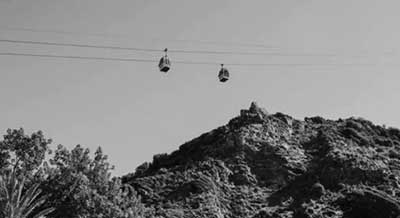Relevance: GS-3: Infrastructure: Energy, Ports, Roads, Airports, Railways etc.
Key Phrases: Ecologically sustainable alternative, PPP mode, Regulatory regime, Mass transit systems, Land acquisition, Low footprint, 3S (a kind of cable car system) technology
Why in News?
- Union Finance Minister Smt Nirmala Sitharaman, while presenting Union Budget for 2022-23 announced National Ropeways Development Programme - “Parvatmala” - will be taken up on PPP mode, which will be a preferred ecologically sustainable alternative in place of conventional roads in difficult hilly areas.
Background:
- Developing an efficient transport network is a big challenge in hilly areas. The rail and air transport networks are limited in these areas, while the development of the road network has technical challenges. In this backdrop, Ropeways have emerged as a convenient and safe alternate transport mode.
- The Ministry of Road Transport and Highways (MORTH) has initiated a study carried out by M/s Mckinsey & Co. for Ropeway development in the country. The study suggested that MORTH may take National Ropeway Development Programme named “Parvatmala”, similar to the “Bharatmala” programme.
- Therefore, the Government has decided to develop Ropeways in hilly areas of the country. The Ministry of Road Transport and Highways (MORTH) has so far been responsible for development of Highways and regulating the road transport sector across the country. However, in February 2021, the Government of India (Allocation of Business) Rules 1961 was amended, which enables the Ministry to also look after the development of Ropeways and Alternate Mobility Solutions.
Features of National Ropeways Development Programme - “Parvatmala”:
- Setting up a regulatory regime: The Ministry of Road
Transport and Highways will look after the infrastructure
construction.
- The Ministry will also have responsibility for development of ropeway and alternative mobility solutions technology, as well as construction, research, and policy in this area.
- Framework: Formulation of institutional, financial, and regulatory framework for the technology will also fall under the ambit of this allocation.
- Project development under PPP (Public Private Partnership) mode, to ensure private sector participation and efficient maintenance of ropeways.
- Coverage: This may also cover congested urban areas, where
conventional mass transit systems are not feasible.
- The Finance Minister announced that contracts for 8 ropeway projects for a length of 60 km would be awarded in 2022-23.
- The scheme is being presently started in regions like Uttarakhand, Himachal Pradesh, Manipur, Jammu & Kashmir and the other North Eastern states.
The idea is to improve connectivity and convenience for commuters, besides promoting tourism.
MAJOR FACTORS DRIVING ROPEWAY INFRASTRUCTURE
- Economical mode of transportation: Given that ropeway projects are built in a straight line over a hilly terrain, it also results in lower land acquisition costs. Hence, despite having a higher cost of construction per km than roadways, ropeway projects’ construction cost may happen to be economical than roadways.
- Faster mode of transportation: Owing to the aerial mode of transportation, ropeways have an advantage over roadway projects where ropeways can be built in a straight line, over a hilly terrain.
- Environmentally friendly: Low dust emissions. Material containers can be designed so as to rule out any soiling of the environment.
- Last mile connectivity: Ropeway projects adopting 3S (a kind of cable car system) or equivalent technologies can transport 6000-8000 passengers per hour.
BENEFITS OF ROPEWAYS
- Ideal for difficult / challenging / sensitive terrain: As
ropeways don't disturb the terrain like roads and railways construction
does.
- Long rope spans: The system crosses obstacles like rivers, buildings, ravines, or roads without a problem.
- Ropes guided over towers: Low space requirements on the ground, and no barrier for humans or animals.
- Economy: Ropeway having multiple cars propelled by a single
power-plant and drive mechanism. This reduces both construction and
maintenance costs.
- The use of a single operator for an entire ropeway is a further saving, in labor cost. On level ground, the cost of ropeways is competitive with narrow-gauge railroads; in the mountains the ropeway is far superior.
- Flexible: Transport of different materials - A ropeway allows for the simultaneous transport of different types of material.
- Ability to handle large slopes: Ropeways and cableways (cable
cranes) can handle large slopes and large differences in elevation. Where a
road or railroad needs switchbacks or tunnels, a ropeway travels straight up
and down the fall line.
- For example: The old cliff railways in England and ski resort ropeways in the mountains take advantage of this feature.
- Low footprint: The fact that only narrow-based vertical supports are needed at intervals, leaving the rest of the ground free, makes it possible for ropeways to be constructed in built-up areas and in places where there is intense competition for land use.
Conclusion:
- This mode of transportation will enable mobility to people living in difficult areas and help them become part of the mainstream. Villagers / farmers living in such areas will be able to sell their produce in other areas, which in turn will help them grow their income.
- An MoU has been signed with Uttarakhand Tourism Development Board (UTDB), Govt. of Uttarakhand, for development of Ropeways in the State. Initially, seven projects have been identified in Uttarakhand. DPR for Kedarnath and Hemkund Sahib Ropeway is in progress and NIT for the same has been invited. Proposals have also been received from Governments of Himachal Pradesh, Manipur, Arunachal Pradesh, Sikkim, Maharashtra, Jammu and Kashmir for development of Ropeways.
Sources: PIB
Mains Question:
Q. Recently Union Budget for 2022-23 announced National Ropeways Development Programme – “Parvatmala”. What are the major factors responsible for creating ropeway infrastructure in hill areas. Discuss the features of Parvatmala programme and the benefits associated with it. [250 words]









